If you’re a pepper plant parent, you may have noticed some yellow spots on the leaves of your plant. While it may be alarming at first, there are a few common causes of yellowing leaves on pepper plants. In this article, we’ll discuss 7 causes of yellow spots on pepper leaves and how to treat them.
Pepper Plant Leaf Diseases
If you notice yellow spots on your pepper plant leaves, it’s important to figure out the cause so you can treat the plant accordingly. Here are seven possible causes of yellow spots on pepper leaves, along with treatment options for each.
Nutrient Deficiencies 1.
To correct a nutrient deficiency, you’ll need to fertilize your plant with a balanced fertilizer. Yellow spots on pepper leaves can be a sign of nutrient deficiencies, such as a lack of nitrogen, phosphorus, or potassium.
Pest Infestation 2.
Yellow spots can also be caused by pests, such as aphids, whiteflies, or spider mites. If you suspect a pest infestation, inspect your plant carefully and treat with an appropriate pesticide.
Disease 3.
There are several diseases that can cause yellow spots on pepper leaves, such as bacterial leaf spot, early blight, or powdery mildew. If you think your plant has a disease, it’s best to consult with a professional to get an accurate diagnosis and treatment plan.
Environmental Stress 4.
Environmental stressors, such as too much or too little sun, water, or heat, can also cause yellow spots on pepper leaves. To correct environmental stress, you’ll need to adjust the growing conditions of your plant.
Herbicide Damage 5.
If you’ve recently applied herbicides to your garden, it’s possible that the chemicals have damaged your pepper plants. If you suspect herbicide damage, stop using the chemicals and try to nurse your plants back to health.
6. Genetic Disorder
In some cases, yellow spots on pepper leaves may be due to a genetic disorder. If you suspect a genetic disorder, there’s unfortunately not much you can do to treat it.
7. Old Age
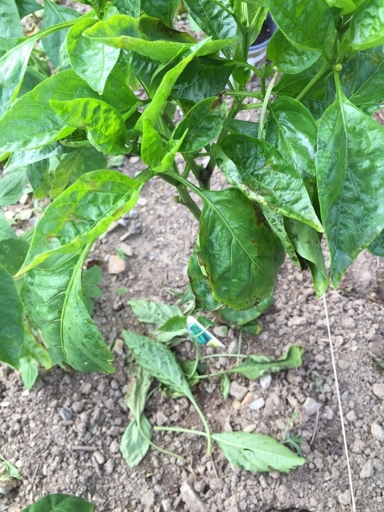
This is normal and nothing to worry about. As pepper plants age, their leaves may start to turn yellow.
There are a number of possible causes, and with a little investigation, you should be able to figure out the problem. Once you know the cause, you can take the appropriate steps to treat your plant. If you notice yellow spots on your pepper plant leaves, don’t panic!
Phytophthora Blight
This fungal disease thrives in warm, wet conditions and can quickly spread to other plants in your garden. Treatment involves removing affected leaves and stems, as well as applying a fungicide to the affected area. If you notice yellow spots on your pepper leaves, it’s likely due to Phytophthora blight.
Treatment
If you notice yellow spots on your pepper leaves, don’t despair! There are a few possible causes and treatments.
Peppers need a lot of nutrients, so make sure you are fertilizing regularly. One common cause of yellow spots is nutrient deficiency. If you think your plants might be deficient in a particular nutrient, you can try giving them a foliar spray of that nutrient.
If you see any pests on your plants, be sure to remove them and treat the plants with an appropriate pesticide. Yellow spots can also be caused by pests or diseases. If you suspect a disease, you can try treating the plants with a fungicide.
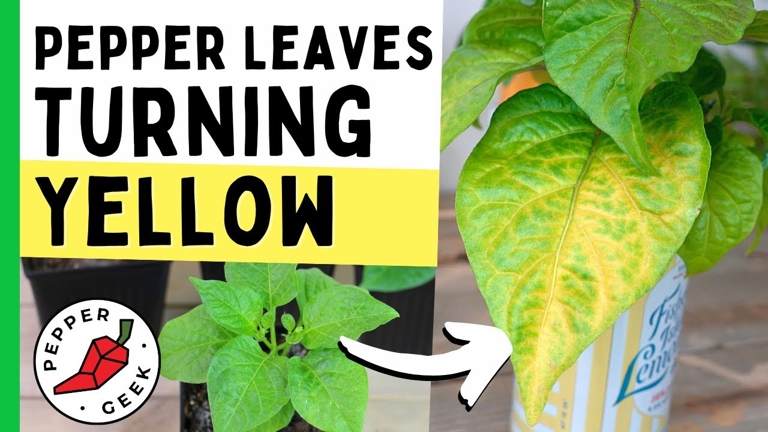
Finally, yellow spots can sometimes be caused by too much sun exposure. If you think this might be the case, try moving your plants to a shadier spot.
If you follow these tips, your pepper plants should soon be looking healthy and green!
Anthracnose
The fungus can be controlled with the use of fungicides. The spots may be circular or irregular in shape. The fungus can also cause the leaves to curl and the fruit of the pepper plant to rot. The disease is characterized by yellow spots on the leaves of the plant. Anthracnose is most likely to occur during wet weather conditions. Anthracnose is a fungal disease that can affect pepper plants.
Treatment
There are a few things that can cause yellow spots on pepper leaves. Another is too much sun exposure, which can be remedied by shading the plant. One is a lack of nutrients, which can be remedied by fertilizing the plant. Finally, it could be a fungal or bacterial disease, in which case you’ll need to treat the plant with an appropriate fungicide or bactericide.
Bacterial Leaf Spot
Bacterial leaf spot can be caused by several different bacteria, including Pseudomonas, Xanthomonas, and Erwinia. Treatment for bacterial leaf spot usually involves using a fungicide. The spots are usually yellow, but can also be brown or black. The spots are often surrounded by a yellow halo. Bacterial leaf spot is a common problem for pepper plants.
Treatment
The yellow spots on pepper leaves are most likely caused by a nutrient deficiency, pests, or disease. To treat the yellow spots, you can try adding more nutrients to the soil, controlling pests, or treating the disease.
If the yellow spots are caused by a nutrient deficiency, you can try adding more fertilizer to the soil. You can also try adding compost to the soil to help improve its quality. Make sure to use a fertilizer that is high in nitrogen, as this will help promote healthy growth.
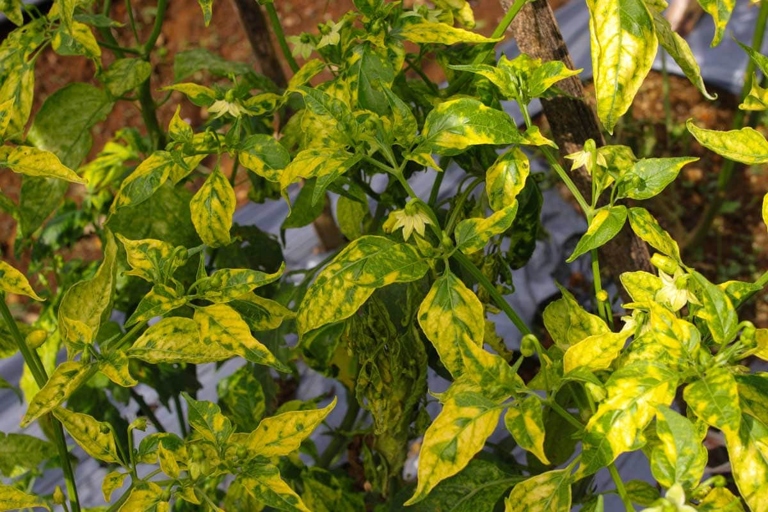
If the yellow spots are caused by pests, you can try using an insecticide to control them. You can also try using traps or barriers to keep the pests away from the plants. Be sure to follow the instructions on the label carefully.
If the yellow spots are caused by disease, you can try treating the plants with a fungicide. Be sure to follow the instructions on the label carefully. You can also try removing the affected leaves to prevent the disease from spreading.
Powdery mildew
The fungus causing the disease is most active in warm, humid conditions and can quickly spread to cover the entire plant. The fungus can also reduce the yield and quality of the peppers. Powdery mildew is one of the most common problems that pepper growers face. Powdery mildew can cause the leaves of pepper plants to turn yellow and eventually drop off.
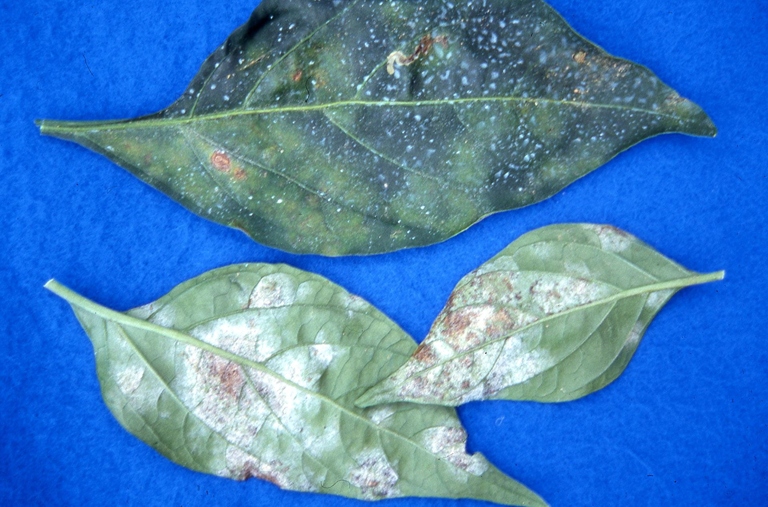
To prevent powdery mildew, it is important to water pepper plants at the base and not from above. If powdery mildew does occur, it can be treated with a fungicide. Good air circulation around the plants will also help to prevent the fungus from spreading. The leaves should also be kept dry.
Treatment
In most cases, this is a sign of a nutrient deficiency and can be easily fixed with some simple treatments. If you notice yellow spots on your pepper leaves, don’t panic!

One common cause of yellow spots on pepper leaves is a lack of nitrogen. You can also add compost or manure to your soil to help boost its nitrogen content. This can be remedied by fertilizing your plants with a nitrogen-rich fertilizer.
This can be fixed by adding Epsom salt to your soil. Simply mix 1 tablespoon of Epsom salt with 1 gallon of water and apply it to your plants’ roots. Another common cause of yellow spots is a lack of magnesium.
Be sure to follow the directions on the label carefully. If you suspect that your yellow spots are caused by a fungal disease, you can treat them with a fungicide.
Finally, if you have yellow spots on your pepper leaves and you’re not sure what the cause is, try treating them with a general-purpose fertilizer. This will provide your plants with a boost of nutrients that they may be lacking.
Root and Stem Rot
These fungi attack the roots and stem of the pepper plant, causing the plant to wilt and the leaves to turn yellow. Treatment for root and stem rot includes removing affected plants, improving drainage, and increasing air circulation. Root and stem rot is caused by a variety of fungi, including Pythium and Phytophthora. Pepper plants are susceptible to root and stem rot, which can cause yellow spots on the leaves.
Treatment
If you notice yellow spots on your pepper leaves, don’t panic! There are a few possible causes and treatments.
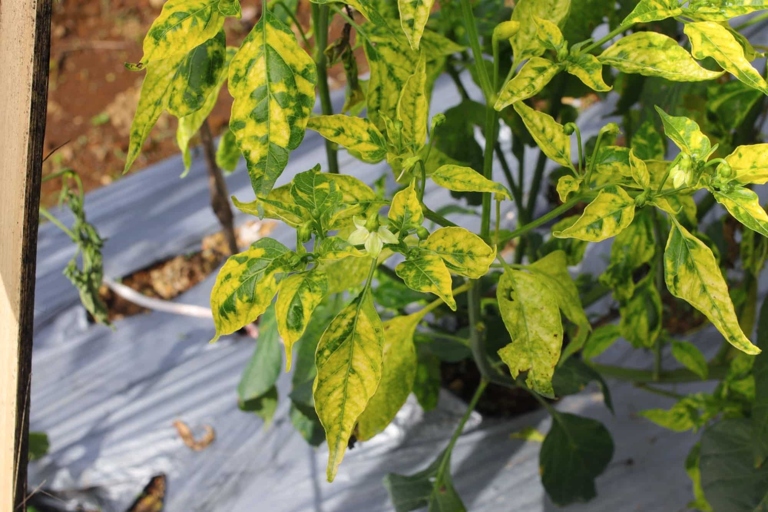
The best way to treat a nutrient deficiency is to amend the soil with compost or other organic matter. One common cause of yellow spots is a nutrient deficiency. Peppers need a lot of nutrients to grow healthy and strong, so if something is lacking in the soil, it can show up as yellow spots on the leaves. You can also try using a fertilizer specifically designed for peppers.
This disease is most common in wet, humid conditions. Be sure to follow the directions on the label carefully, as fungicides can be dangerous if used incorrectly. Yellow spots can also be caused by a fungal disease called Alternaria. If you think your plants have Alternaria, you’ll need to treat them with a fungicide.
If you can’t figure out what’s causing the stress, you may need to consult with a professional. If your plants are wilting, have yellow leaves, and are growing slowly, they may be under stress from too much or too little water, too much or too little sunlight, or something else. Finally, yellow spots can sometimes be a sign of stress.
Verticillium Wilt
Symptoms of verticillium wilt include yellowing or wilting of leaves, stunted growth, and eventually death of the plant. The fungus infects the plant through its roots and then spreads upwards through the plant’s vascular system. Verticillium wilt is a soil-borne fungal disease that can affect a wide range of plants, including peppers. The fungus can survive in the soil for many years, making it difficult to control. Treatment of verticillium wilt includes removing infected plants and solarizing the soil to kill the fungus.
Treatment
There are a few different things that could be causing the problem, and there are treatments for each one. If your pepper plants have yellow spots on their leaves, don’t worry!
One common cause of yellow spots on pepper leaves is a fungal disease called Alternaria. Alternaria can be treated with a fungicide, but it’s important to catch it early. If the disease is allowed to progress, it can kill the plant.
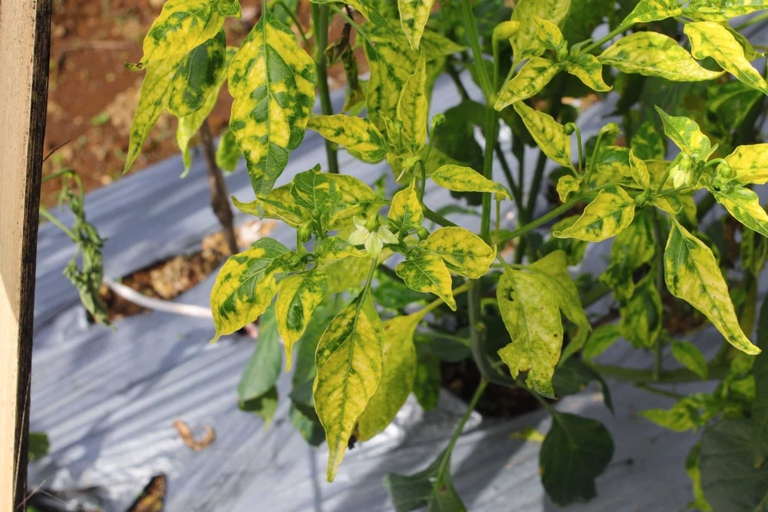
Peppers need a lot of nitrogen, so if your plants are lacking in this nutrient, they may develop yellow spots. Another common cause of yellow spots is a nutrient deficiency. You can treat a nutrient deficiency by fertilizing your plants with a nitrogen-rich fertilizer.
You can protect your plants from too much sun by placing them in a shady spot or by covering them with a cloth during the hottest part of the day. If your pepper plants are getting too much sun, they may develop yellow spots on their leaves. Finally, yellow spots can also be caused by too much sun exposure.
Mosaic Virus
The virus is spread by aphids and other insects that feed on the plant. Mosaic virus is one of the most common viruses that can affect pepper plants. Symptoms of mosaic virus include yellow spots on the leaves, stunted growth, and reduced yields. The virus can be controlled by using insecticides and removing infected plants from the garden.
Treatment
If the leaves are getting too much sun, try to move the plants to a shadier spot. If this is the case, treat the plants with a fungicide according to the manufacturer’s instructions. Finally, yellow spots can also be caused by fungal diseases. This can be remedied by fertilizing the plants with a balanced fertilizer. One common issue that can cause yellow spots on pepper leaves is nutrient deficiency. Another issue that can cause yellowing leaves is too much sun exposure.
Preventing Disease in Pepper Plants
Preventing disease in pepper plants starts with understanding the 7 most common causes of yellow spots on pepper leaves. Once you know what to look for, you can take steps to prevent the problem before it starts.
Peppers need a lot of nitrogen, so if your plants are lacking in this essential nutrient, they will start to show yellow spots on their leaves. The most common cause of yellow spots on pepper leaves is a nutrient deficiency. The best way to prevent this problem is to make sure your plants are getting enough nitrogen by fertilizing them regularly.
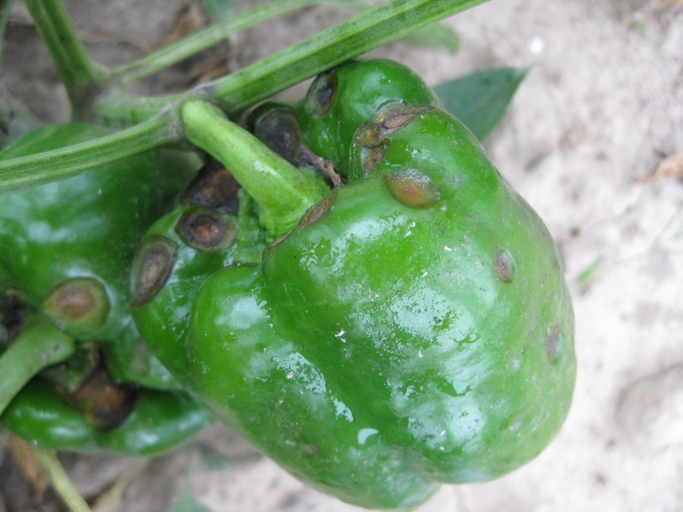
Finally, treat your plants with a fungicide if you see signs of a disease developing. Second, avoid overhead watering, which can promote the growth of fungal diseases. First, make sure your plants have plenty of ventilation so that the leaves can dry out quickly after watering. These diseases can be difficult to control, but there are some things you can do to prevent them from taking hold. Another common cause of yellow spots on pepper leaves is fungal diseases.
You can also take steps to prevent pests from getting into your garden in the first place by keeping it clean and free of debris. Finally, yellow spots on pepper leaves can also be caused by pests. To prevent these pests from damaging your plants, use a pesticide that is specifically designed to kill them. Aphids, whiteflies, and spider mites are all common pests that can attack pepper plants.
Bugs on Pepper Causing Yellow Spots
The most common causes of yellow spots on pepper leaves are sunburn, nutrient deficiencies, and pests. If you notice yellow spots on the leaves of your pepper plants, don’t worry – it’s a common problem that can be caused by a number of different factors.
Sunburn is the most common cause of yellow spots on pepper leaves. The leaves of pepper plants are very sensitive to sunlight, and they can easily get sunburned if they’re exposed to too much direct sunlight. If you notice yellow spots on the leaves of your pepper plants, try moving them to a location that gets less direct sunlight.
If you think your pepper plants might be deficient in one or more of these nutrients, try fertilizing them with a high-quality fertilizer that’s designed for pepper plants. The most common nutrient deficiencies that cause yellow spots on pepper leaves are nitrogen, phosphorus, and potassium. Peppers need a lot of nutrients to grow healthy and strong, and they can develop yellow spots on their leaves if they’re not getting enough of certain nutrients. Nutrient deficiencies are another common cause of yellow spots on pepper leaves.
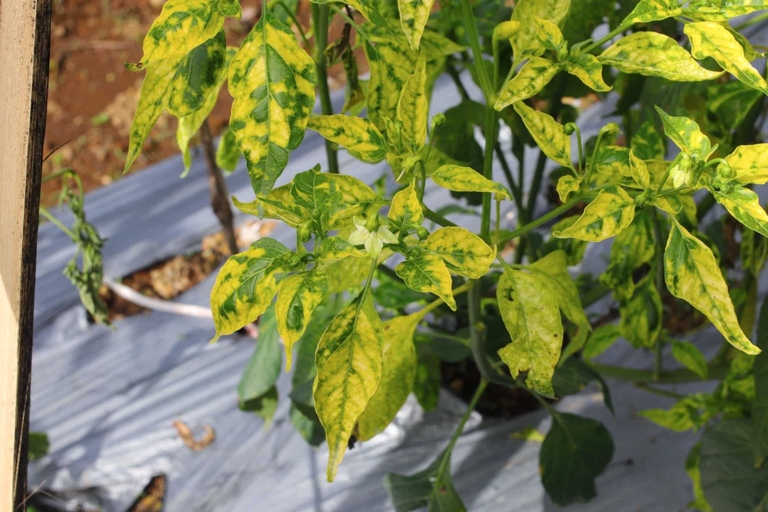
Pests are also a common cause of yellow spots on pepper leaves. Aphids, whiteflies, and spider mites are all common pests that can attack pepper plants and cause yellow spots on their leaves. If you notice yellow spots on the leaves of your pepper plants, inspect them carefully for signs of pests. If you find any pests, try to remove them by hand or treat your plants with an insecticide.
Mealybugs
Mealybugs can weaken and even kill pepper plants if they are not controlled. They are small, white, wingless insects that feed on the sap of plants. Mealybugs are one of the most common pests that attack pepper plants.
They insert their long, piercing mouthparts into the leaf and suck out the sap. This can cause the leaves to turn yellow and eventually drop off. Mealybugs are most often found on the undersides of pepper leaves.
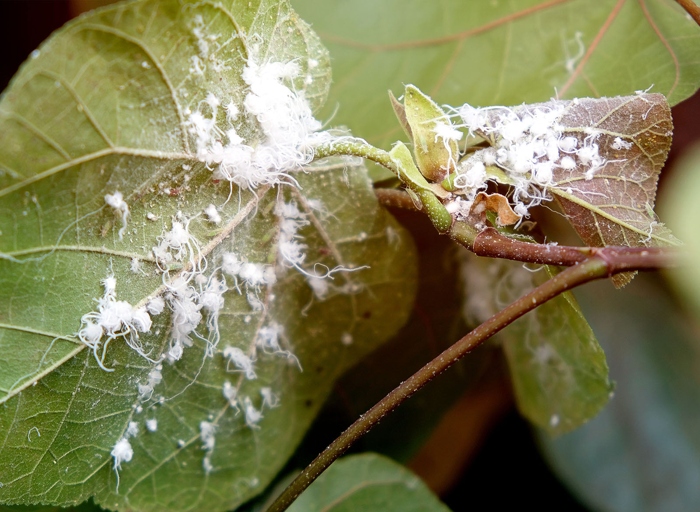
They are often found in greenhouses and gardens, where they can quickly infest a large number of plants. Mealybugs can also spread diseases from one plant to another.
Insecticidal soap or neem oil can also be used to kill them. This can be done by hand-picking them off or using a strong stream of water to blast them off. To control mealybugs, it is important to remove them from the plants as soon as possible.
Spider Mites
They are very small, and are translucent. The plant will also produce fewer peppers. The adults are very small, about the size of a grain of pepper, and are usually red or brown. Spider mites are one of the most common pests that attack pepper plants. The larvae are the stage that does the most damage to the plant. They spin webs on the underside of the leaves, and suck the sap out of the plant. The eggs are even smaller, and are usually white. This causes the leaves to turn yellow, and eventually to drop off.
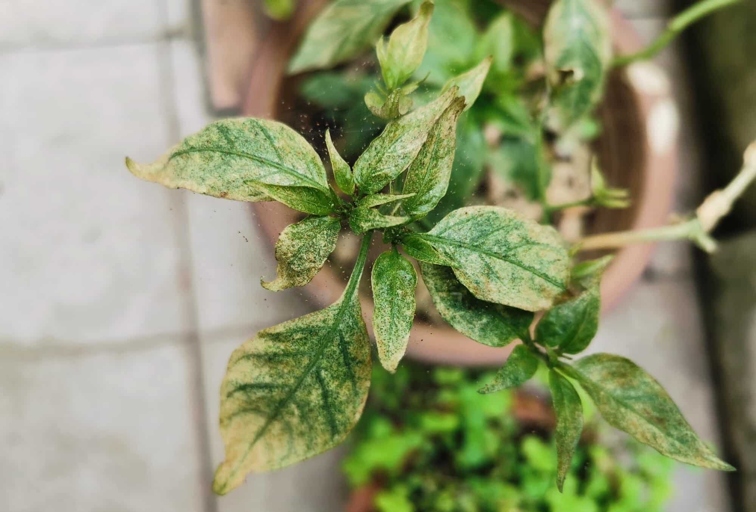
Be sure to follow the directions on the label, and apply the pesticide when the spider mites are most active, which is usually in the evening. These can be found in most garden stores. The most effective are the ones that contain pyrethrin. Spider mites can be controlled with a number of different pesticides.
Scale
Here are 7 possible causes of yellow spots on pepper leaves, as well as some treatment options. If you notice yellow spots on your pepper leaves, it’s important to figure out the cause so you can address it accordingly.
Nutrient Deficiencies 1.
One of the most common causes of yellow spots on pepper leaves is a nutrient deficiency. Peppers need a lot of nutrients to thrive, so if something is off, it can show up in the form of yellow spots. The most common nutrient deficiencies that cause yellow spots are nitrogen, phosphorus, and potassium.
If you suspect a nutrient deficiency, the best course of action is to get a soil test to confirm. From there, you can amend your soil as needed to correct the deficiency.
Pest Infestation 2.
Not only do they cause yellow spots, but they can also lead to stunted growth, leaf drop, and even plant death. Aphids, whiteflies, and spider mites are all common pests that can attack pepper plants. Yellow spots can also be a sign of a pest infestation.
If you see any pests, you’ll need to take action to get rid of them. This may involve using pesticides or other control methods. If you suspect pests are to blame for the yellow spots on your pepper leaves, inspect your plants carefully.
Disease 3.
This disease can also cause leaf drop and plant death if left untreated. The most common is bacterial leaf spot, which is caused by a bacteria called Pseudomonas. There are a few diseases that can cause yellow spots on pepper leaves.
Fungal diseases like powdery mildew and anthracnose can also cause yellow spots. These diseases are often caused by too much moisture, so it’s important to make sure your pepper plants are getting the right amount of water.
Treating diseases can be tricky, so it’s best to consult with a professional to get the best results. If you think disease is to blame for the yellow spots on your pepper leaves, it’s important to take action immediately.
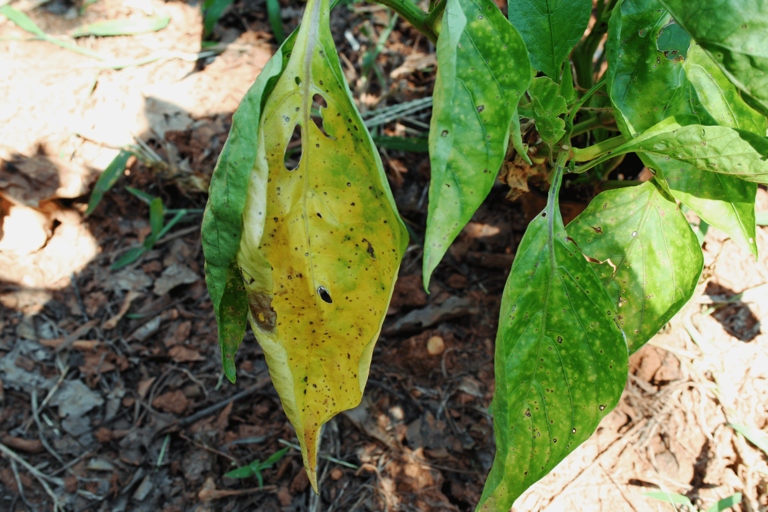
Environmental Stress 4.
Environmental stressors like extreme heat or cold can also cause yellow spots on pepper leaves. If the temperature gets too high or too low, it can cause the leaves to turn yellow and even die.
Other environmental stressors include wind, drought, and too much or too little sunlight. If you think environmental stress is to blame for the yellow spots on your pepper leaves, the best thing you can do is try to provide the plants with more ideal growing conditions.
Herbicide Damage 5.
Herbicides can sometimes drift onto pepper plants and cause damage. If you use herbicides in your garden, it’s possible that they could be the cause of the yellow spots on your pepper leaves.
You may also need to take action to treat the plants that have been damaged. If you think herbicide damage is to blame, the best thing you can do is stop using herbicides in the area where your pepper plants are growing.
6. Genetic Issues
This is most common in hybrid varieties of peppers. If the parents of the hybrid plant don’t have the same genetic makeup, it can cause problems with the plant, including yellow spots on the leaves. Sometimes, the yellow spots on pepper leaves are due to genetic issues.
If you’re having trouble with yellow spots on your pepper leaves, it’s best to consult with a professional to see if this is the cause. There’s not much you can do about genetic issues, but it’s important to be aware of them.
7. Old Age
This is normal and nothing to be concerned about. As plants get older, their leaves can start to turn yellow and die. Finally, sometimes the yellow spots on pepper leaves are simply due to old age.
There are a number of possible causes, so it’s important to narrow it down so you can take action accordingly. If you notice yellow spots on your pepper leaves, the best thing you can do is try to figure out the cause.
Aphids
These pests are often found in large numbers on the undersides of leaves, where they feed on plant sap. This can cause the leaves to turn yellow and eventually die. You can also encourage natural predators, such as ladybugs, to help control the aphid population. Aphids are tiny, soft-bodied insects that can be found in a variety of colors, including yellow. Aphids can cause yellow spots on pepper leaves by sucking out the chlorophyll from the leaves. To control aphids, try using an insecticidal soap or neem oil. Aphids can also transmit diseases from plant to plant.
Treatment
In most cases, yellowing leaves are caused by environmental factors and are not a sign of a serious problem. Here are seven common causes of yellow leaves on pepper plants, along with tips on how to treat them: If you spot yellow leaves on your pepper plants, don’t panic!
Too Much Water 1.
If your pepper plants are getting too much water, the leaves will turn yellow and eventually drop off. To prevent this, make sure you’re only watering your plants when the soil is dry to the touch.
Too Little Water 2.
If you think your plants are thirsty, water them deeply and regularly. On the other hand, if your plants are not getting enough water, the leaves will also turn yellow.
Nutrient Deficiencies 3.
To fix this, fertilize your plants regularly with a good quality fertilizer. Yellow leaves can also be a sign that your plants are lacking in essential nutrients.
4. Pest Infestation
Sometimes, yellow leaves are caused by pests such as aphids or whiteflies. If you see pests on your plants, treat them with an appropriate insecticide.
Disease 5.
If you suspect your plants are sick, take them to a local nursery or garden center for diagnosis and treatment. Disease can also cause yellow leaves.
6. Too Much Sun
To prevent this, make sure you provide your plants with some shade during the hottest hours of the day. If your pepper plants are getting too much sun, the leaves will turn yellow and eventually dry out and fall off.
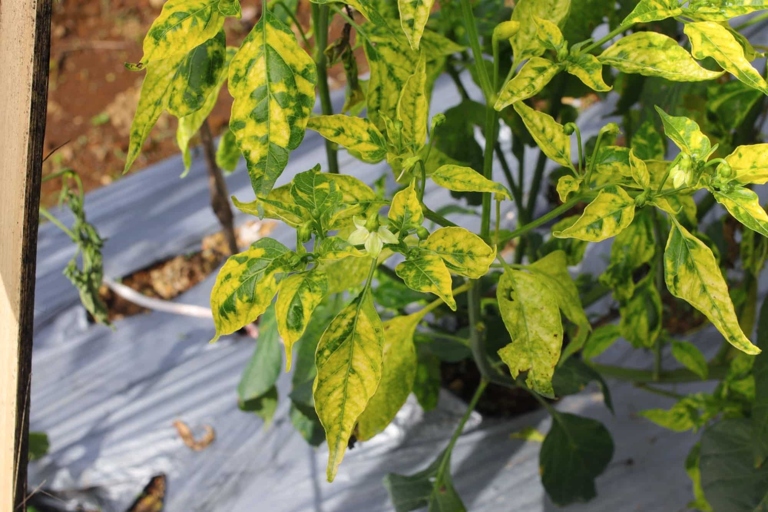
7. Too Little Sun
Finally, if your plants are not getting enough sun, the leaves will also turn yellow. If you think your plants need more light, move them to a sunnier spot.
Edema
It can occur in any part of the body, but is most commonly seen in the legs and feet. Treatment for edema typically involves addressing the underlying cause, as well as lifestyle changes, such as diet and exercise. Edema is a condition that results in the accumulation of fluid in the tissues. Edema is often the result of an underlying medical condition, such as heart failure or kidney disease.
Solution
This will help to flush out any potential toxins that may be causing the yellowing of the leaves. One solution is to simply remove the affected leaves from the plant. This will help to prevent the spread of the problem to other parts of the plant. Finally, if the problem is caused by a lack of nutrients, then fertilizing the plant may be the best solution. Another solution is to increase the amount of water that the plant is receiving. While there are many potential causes of yellow spots on pepper leaves, there are also a number of solutions that can help correct the issue.
Sunscald
The leaves of the pepper plant turn yellow and the fruit may be stunted. You can also use a sunshade or a reflective mulch to reflect sunlight away from the pepper plant. Sunscald is a common problem for pepper plants. The leaves of the pepper plant are sunburned and the fruit is not getting enough sunlight. Sunscald is caused by too much sun exposure. The best way to prevent sunscald is to provide shade for the pepper plant.
Solution
The fungicide will kill the fungus that is causing the spots. The solution to yellow spots on pepper leaves is to treat the plant with a fungicide.
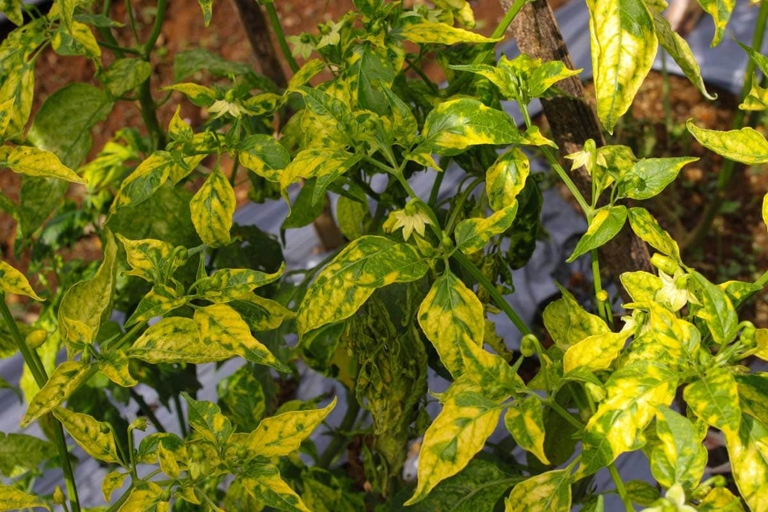
If the spots are caused by a virus, there is no cure. The plant will have to be destroyed.
If the spots are caused by a nutrient deficiency, the plant can be treated with a fertilizer.
Improper Watering
One of the most common problems when it comes to growing peppers is improper watering. This can manifest in a number of ways, including yellow spots on the leaves.
Second, if you’re underwatering your plants, the leaves will also turn yellow. First, if you’re overwatering your plants, the leaves will start to turn yellow. This is because the roots are not getting enough water and the plant is stressed. This is because the roots are getting too much water and the plant can’t take it up fast enough. There are a few things that can cause this problem.
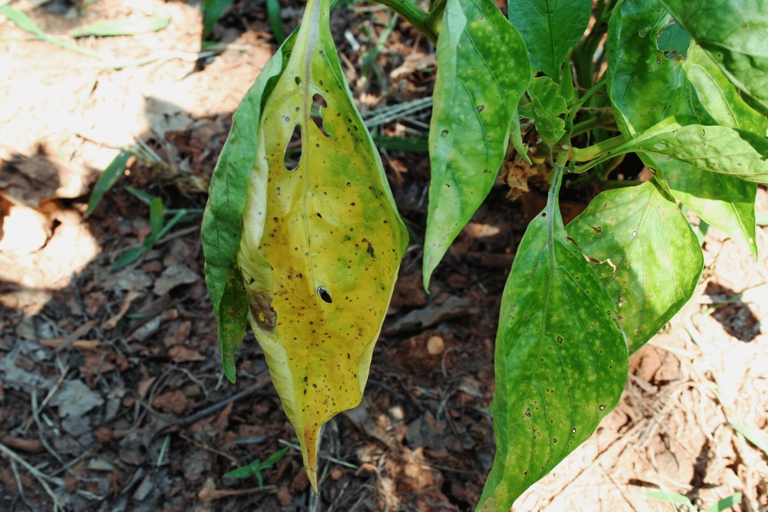
If you’re underwatering, increase the amount of water you’re giving them. Once you find the right balance, your plants should start to look better. The best way to fix this problem is to simply adjust your watering schedule. If you’re overwatering, cut back on the amount of water you’re giving your plants.
Solution
There are a few possible causes and solutions. If you notice yellow spots on your pepper leaves, don’t panic!
One common cause of yellow spots is a nutrient deficiency. Peppers need a lot of nutrients to grow healthy and strong, so make sure you are fertilizing regularly. If you think a nutrient deficiency may be the problem, you can try using a fertilizer designed for peppers.
Peppers need some sun to grow, but too much sun can damage the leaves. If you think your pepper plants are getting too much sun, try moving them to a shadier spot. Another possible cause of yellow spots is too much sun.

If the problem persists, you may need to use an insecticide. If you think your plants have a disease, you should consult a professional for treatment options. If you see any pests on your plants, try to remove them by hand. Finally, yellow spots can also be caused by pests or diseases.
Nutrient Deficiency
One common reason for yellow spots on pepper leaves is nutrient deficiency. If your plants are not getting enough of these nutrients, they will start to show signs of stress, including yellowing leaves. This can be caused by a lack of nitrogen, phosphorus, or potassium in the soil.
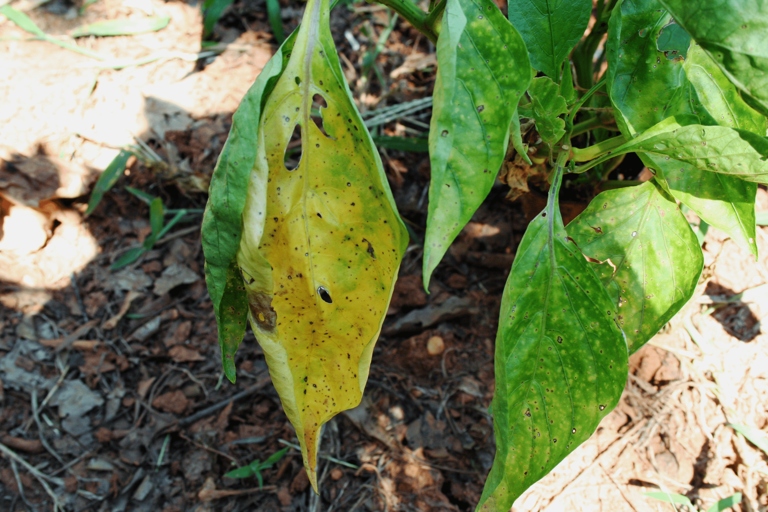
Once you have corrected the deficiency, the yellowing leaves should start to recover. To correct a nutrient deficiency, you will need to add more of the missing nutrient to the soil. This can be done by using a fertilizer that contains the nutrient, or by adding amendments to the soil.
Solution
If you’re noticing yellow spots on your pepper leaves, don’t worry – there are a few possible causes and solutions.
One common cause of yellow spots on pepper leaves is a deficiency in nitrogen. This can be remedied by adding a nitrogen-rich fertilizer to your plant’s soil.

Another possible cause is a fungal disease called Alternaria. This can be treated with a fungicide.
If this is the case, simply move your plant to a shadier spot. Finally, yellow spots can also be caused by too much sun exposure.
With a little troubleshooting, you should be able to figure out the cause of the yellow spots on your pepper leaves and get your plant back to good health in no time.
Fertilizer Burn
It occurs when the fertilizer is applied too heavily or too close to the plant, and the chemicals in the fertilizer burn the leaves. If you do accidentally burn your plants, you can try to save them by watering them deeply and giving them plenty of sunlight. Fertilizer burn can be prevented by following the directions on the fertilizer label and applying the fertilizer at the correct rate. Fertilizer burn is one of the most common problems that gardeners face.
Solution
If the spots are caused by a fungal disease, the solution is to treat the plant with a fungicide. This can be done by adding compost or manure to the soil around the plant, or by using a nitrogen-rich fertilizer. The most common solution for yellow spots on pepper leaves is to provide the plant with more nitrogen. If the spots are caused by a lack of water, the solution is to water the plant more frequently.
How to Prevent Yellow Spots on Pepper
One of the most common problems that pepper growers face is yellow spots on their pepper leaves. While there are several possible causes of this problem, there are a few things that you can do to prevent it from happening.
Yellow spots on pepper leaves are often caused by drought stress, so it is important to keep your plants well-watered. If you live in an area with high temperatures, you may need to water your plants more often than usual. One of the most important things that you can do is to make sure that your plants are getting enough water.
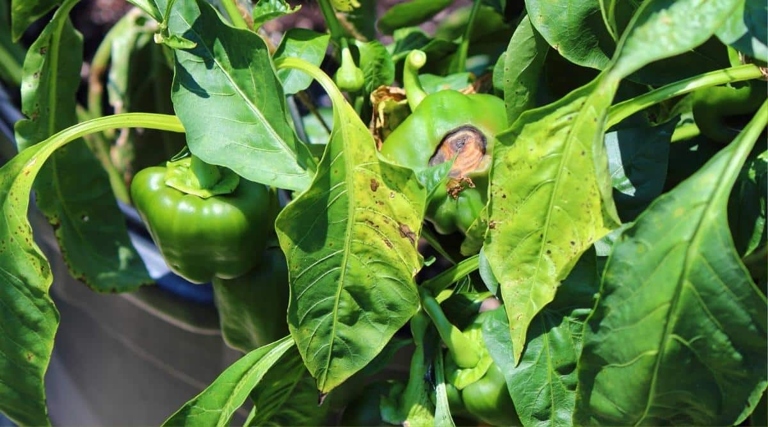
Another thing that you can do to prevent yellow spots on pepper leaves is to make sure that your plants are getting enough nutrients. You can provide your plants with nitrogen by using a fertilizer that contains this nutrient. If your plants are not getting enough nitrogen, they may start to show yellow spots.
Finally, you can also prevent yellow spots on pepper leaves by making sure that your plants are not being damaged by pests. If you see any pests on your plants, you should remove them immediately. You can also use a pesticide to prevent pests from damaging your plants.
Frequently Asked Questions
1. What are the 7 causes of yellow spots on pepper leaves?
2. What are the most common causes of yellow spots on pepper leaves?
3. What are the symptoms of each cause of yellow spots on pepper leaves?
4. How can I treat yellow spots on pepper leaves?
5. What is the best way to prevent yellow spots on pepper leaves?
1. The 7 causes of yellow spots on pepper leaves are: nutrient deficiencies, pests, diseases, environmental stress, herbicide injury, genetic disorders, and physical damage.
2. The most common causes of yellow spots on pepper leaves are: nutrient deficiencies, pests, diseases, and environmental stress.
3. The symptoms of each cause of yellow spots on pepper leaves are:
-Nutrient deficiencies: yellow leaves with green veins, stunted growth, and small fruits.
-Pests: yellow leaves with stippling or discoloration, and chewed leaves.
-Diseases: yellow leaves with spots, blotches, or lesions.
-Environmental stress: yellow leaves with brown or scorched edges.
-Herbicide injury: yellow leaves with burned or wilted appearance.
-Genetic disorders: yellow leaves with mottling or variegation.
-Physical damage: yellow leaves with bruises, tears, or holes.
4. The best way to treat yellow spots on pepper leaves is to remove the affected leaves and destroy them. If the problem is severe, you may need to use a fungicide or insecticide.
5. The best way to prevent yellow spots on pepper leaves is to practice good gardening hygiene, such as: removing debris, weeds, and sick plants; rotating crops; and using mulch.
Final thoughts
If you notice yellow spots on your pepper leaves, it could be due to one of these seven causes. Thankfully, most of these causes can be treated with simple solutions. By paying close attention to your plants and taking quick action, you can keep your pepper plants healthy and prevent yellow spots from returning.
